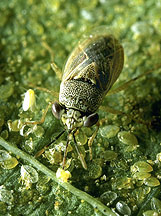Big-eyed Bug

Having glued a hapless whitefly to a leaf (above), the big-eyed bug can devour its prey at its leisure. Photo by Jack Dykinga.
Bigeyed bug adults and nymphs are oval, somewhat flattened, about 4 mm (1/6 of an inch) long, usually brownish or yellowish, and have a wide head with prominent bulging eyes. Bigeyed bugs can be confused with other hemipterans in the same family (Lygaeidae) as well as insects in the Miridae family. Other Lygaeids are more slender and have smaller eyes when compared to Geocoris spp. Bugs in the Miridae family do not have their eyes spaced widely apart, generally have longer antennae and only have one or two closed cells in the tip of their forewings. Bigeyed bugs undergo incomplete metamorphosis with 5 nymphal instars. Females lay oblong, pale-colored eggs singly on leaf surfaces which develop reddish eyespots shortly after being laid. Bigeyed bugs are common on low-growing plants including many field and row crops in which they stalk their prey. Their widely separated eyes give them an extensive field of vision for spotting their prey which includes insect eggs, other bugs, small caterpillars, flea beetles, and mites.
Recource: University of California